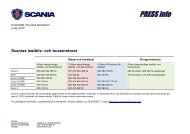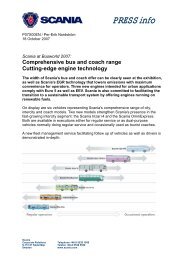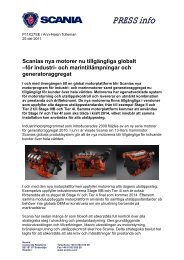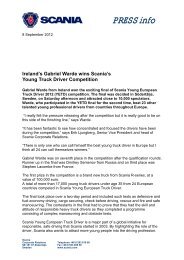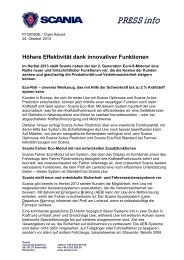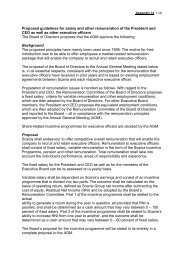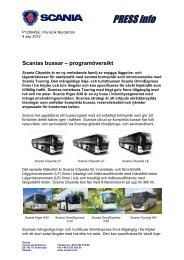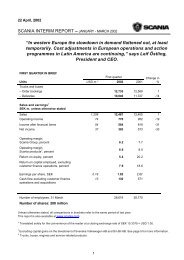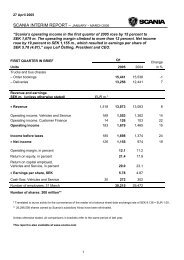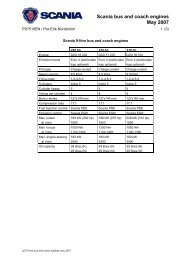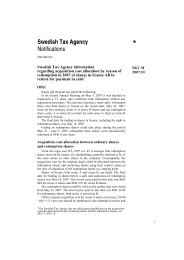Scania Annual Report 2011
Scania Annual Report 2011
Scania Annual Report 2011
Create successful ePaper yourself
Turn your PDF publications into a flip-book with our unique Google optimized e-Paper software.
38 production<br />
Greater flexibility with new agreement<br />
During the summer, <strong>Scania</strong> reached a new agreement<br />
with the Swedish Metal Workers’ Union as part of the<br />
company’s efforts to boost flexibility at its production<br />
units in Sweden. The agreement regulates flexible<br />
working hours and flexible staffing and is an important<br />
element of <strong>Scania</strong>’s ability to respond to rapid changes<br />
in demand. It also increases <strong>Scania</strong>’s chances of retaining<br />
core competency at its Swedish production units in<br />
the long term.<br />
Under the new agreement, most flexible staffing will<br />
consist of personnel from staffing companies. The share<br />
of total production employees consisting of flexible staffing<br />
will not exceed 30 percent.<br />
Close collaboration with sub-contractors<br />
Of <strong>Scania</strong>’s total production costs, about 70 percent<br />
consist of purchased materials and components. Most<br />
of <strong>Scania</strong>’s sub-contractors have had a long-term<br />
relationship with the company. This allows for close<br />
cooperation, where a supplier’s production is increasingly<br />
integrated into <strong>Scania</strong>’s production network. This<br />
has clear benefits for <strong>Scania</strong>’s customers by means of<br />
higher product quality and reliability.<br />
For example, such cooperation includes training in<br />
the <strong>Scania</strong> Production System (SPS), help with improving<br />
the efficiency of production equipment and logistics<br />
as well as environmental work.<br />
<strong>Scania</strong> is also expanding its cooperation with bodybuilding<br />
companies that supply and assemble special<br />
equipment on vehicles. Integrating bodybuilding companies<br />
more closely into the chain leads to substantial<br />
time savings for the customer from the order date until a<br />
vehicle goes into operation and also broadens <strong>Scania</strong>’s<br />
business.<br />
Increase in capacity<br />
While ensuring the flexibility to meet short-term fluctuations,<br />
<strong>Scania</strong> has decided to raise its annual technical<br />
production capacity, with the aim of reaching 120,000<br />
vehicles from about 100,000 at present. Investments<br />
to achieve a 120,000 vehicle capacity will total about<br />
SEK 1.5 billion during a three-year period.<br />
This increase is a step on the way towards reaching a<br />
technical production capacity of 150,000 vehicles by the<br />
next peak in the economic cycle. This can be achieved<br />
with limited investments at the existing production units<br />
due to the gains in efficiency that are continually being<br />
achieved by working according to the <strong>Scania</strong> Production<br />
System (SPS).<br />
The largest investments in new capacity will occur<br />
at engine and cab production units in both Europe and<br />
Latin America.<br />
New regional product centre<br />
<strong>Scania</strong>’s strategy is to strengthen its position in key<br />
emerging markets by establishing regional product<br />
centres for assembling, bodyworking and fitting out<br />
locally-adapted vehicles. <strong>Scania</strong> is thus moving the<br />
factory gate closer to the customer, resulting in shorter<br />
delivery times and a major improvement in customer<br />
support. The task of opening a new facility in India has<br />
begun.<br />
Global healthy attendance<br />
%<br />
100<br />
75<br />
50<br />
25<br />
Antal producerade fordon per anställd<br />
Number of vehicles produced per employee<br />
Medarbetare – frisknärvaro globalt ENG<br />
Vehicles<br />
Employees<br />
Vehicles produced<br />
per employee<br />
78,300 80,400 84,000<br />
Production Sales and services<br />
units<br />
operations<br />
6.8<br />
67,700<br />
7.2<br />
96.3 96.3 97.2 97.5<br />
55,600 6.6<br />
6.6<br />
31,800<br />
3.0<br />
46,400<br />
3.5<br />
4.8<br />
3.8<br />
35,800<br />
12,000 13,100 11,600 11,800 11,800 9,500 10,300 11,700<br />
Number of employees*, <strong>2011</strong><br />
Södertälje 10,640<br />
São Paulo 3,527<br />
Oskarshamn 1,690<br />
Zwolle 1,460<br />
Słupsk 706<br />
Angers 590<br />
Luleå 585<br />
Tucumán 568<br />
0<br />
10<br />
11<br />
10<br />
11<br />
90 95 00 07 08 09 10 11<br />
Global healthy attendance<br />
among employees at <strong>Scania</strong>’s<br />
production units remained at<br />
the same level as in 2010.<br />
In <strong>2011</strong>, productivity reached its highest-ever level. This was a result<br />
of <strong>Scania</strong>’s day-to-day efforts to achieve continuous improvements,<br />
thereby also eliminating waste of time and materials as well as environ -<br />
mental waste. Vehicle production reached its highest-ever level, with<br />
84,000 units produced during the year.<br />
* Refers to the total number<br />
of employees at <strong>Scania</strong>’s<br />
production sites.<br />
<strong>Report</strong> of the directors <strong>Scania</strong> <strong>2011</strong>



